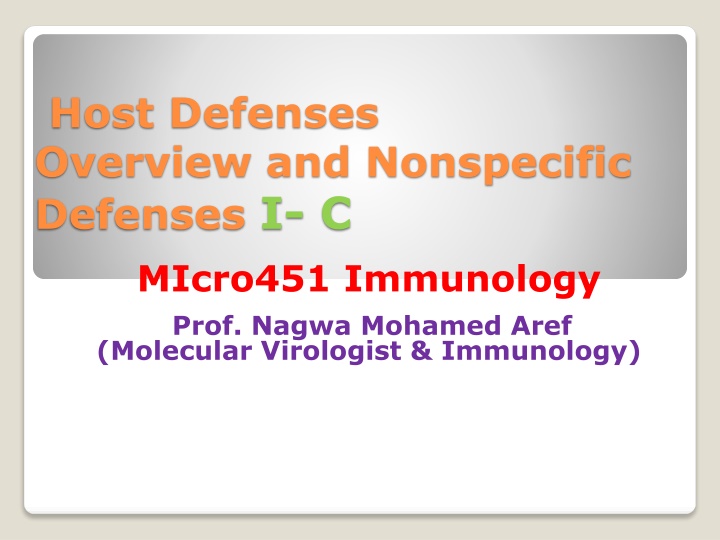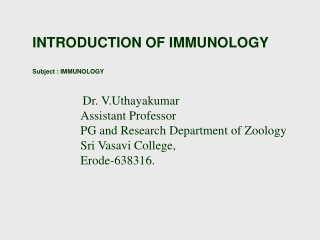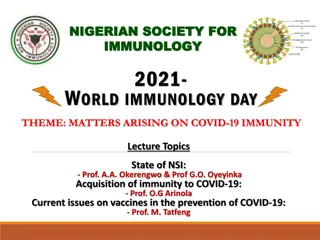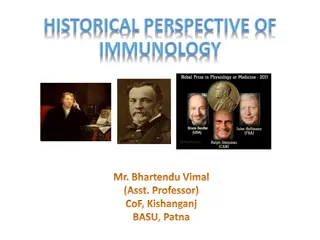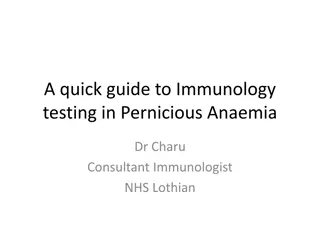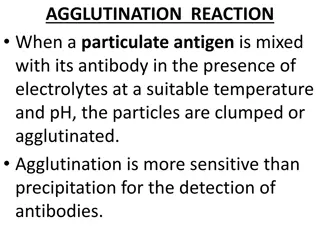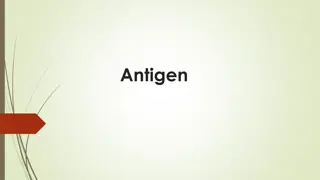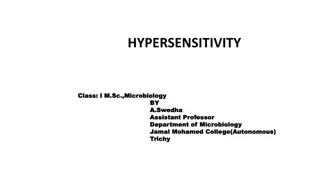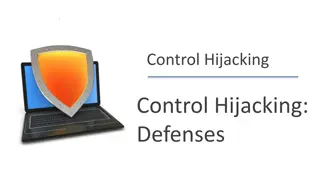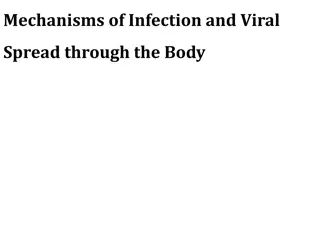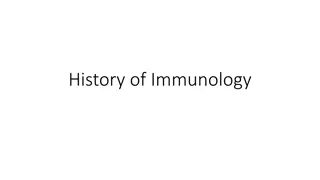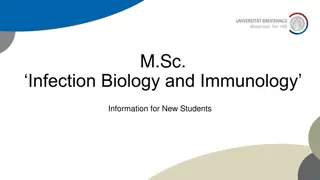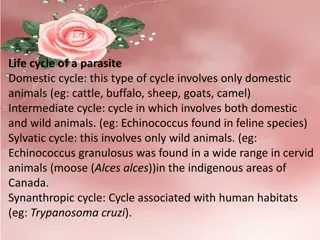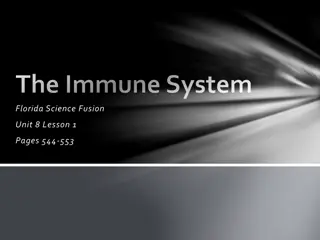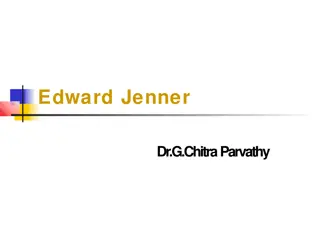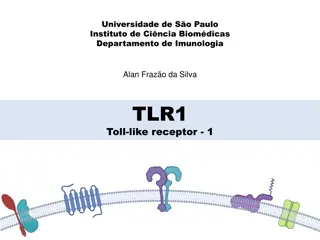Host Defenses Overview - Nonspecific Defenses in Immunology
The immune system's second line of defense involves inflammation, phagocytosis, interferon, and complement responses to injury. The stages and functions of inflammation play crucial roles in mobilizing immune components, repairing tissue damage, and combating microbial invasion through a complex series of reactions.
Download Presentation

Please find below an Image/Link to download the presentation.
The content on the website is provided AS IS for your information and personal use only. It may not be sold, licensed, or shared on other websites without obtaining consent from the author.If you encounter any issues during the download, it is possible that the publisher has removed the file from their server.
You are allowed to download the files provided on this website for personal or commercial use, subject to the condition that they are used lawfully. All files are the property of their respective owners.
The content on the website is provided AS IS for your information and personal use only. It may not be sold, licensed, or shared on other websites without obtaining consent from the author.
E N D
Presentation Transcript
Host Defenses Overview and Nonspecific Defenses I- C MIcro451 Immunology Prof. Nagwa Mohamed Aref (Molecular Virologist & Immunology)
Inflammation Phagocytosis Interferon Complement 2. The Second Line of Defense
Reaction to any traumatic event in the tissues Classic signs and symptoms Rubor (redness) Calor (warmth) Tumor (swelling) Dolor (pain) Fifth symptom has been added: loss of function The Inflammatory Response: A Complex Concert of Reactions to Injury
Blood vessels dilate in response to chemical mediators and cytokines Edema swells tissues, helping prevent spread of infection WBC s, microbes, debris and fluid collect to form pus Pyrogens may induce fever Macrophages and neutrophils engage phagocytosis 1. 2. 3. 4. 5. Stages of inflammation 5
Chief functions of inflammation Mobilize and attract immune components to the site of the injury Set in motion mechanisms to repair tissue damage and localize and clear away harmful substances Destroy microbes and block their further invasion Chief Functions of Inflammation
The Stages of Inflammation Figure 14.13
Controlled by nervous stimulation, chemical mediators, and cytokines released by blood cells, tissue cells, and platelets in the injured area Vasoactive mediators affect the endothelial cells and smooth muscle cells of blood vessels Chemotactic factors (chemokines) affect white blood cells Cause fever, stimulate lymphocytes, prevent virus spread, and cause allergic symptoms Arterioles constricted at first but quickly vasodilation takes place Vascular Changes: Early Inflammatory Events
Exudates: the fluid that escapes through gaps in the walls of postcapillary venules Accumulation of exudates causes edema Contains plasma proteins, blood cells, and cellular debris May be clear (serous) or may contain red blood cells or pus Diapedesis: how WBCs leave the blood vessels and into tissue spaces Chemotaxis: the tendency of WBCs to migrate in response to a specific chemical stimulus Edema: Leakage of Vascular Fluid into Tissues
Dilutes toxic substances Fibrin clot can trap microbes and prevent further spreading Phagocytosis occurs immediately Benefits of Edema and Chemotaxis
An abnormally elevated body temperature FUO: fevers of unknown origin Initiation of fever Pyrogen sets the hypothalamic thermostat to a higher setting Muscles increase heat production Peripheral arterioles decrease heat loss through vasoconstriction Pyrogens can be exogenous or endogenous Fever: An Adjunct to Inflammation
Inhibits multiplication of temperature- sensitive microorganisms Impedes the nutrition of bacteria by reducing the availability of iron Increases metabolism and stimulates immune reactions and naturally protective physiological processes Benefits of Fever
General activities of phagocytes Survey the tissue compartments and discover microbes, particulate matter, and injured or dead cells Ingest and eliminate these materials Extract immunogenic information (antigens) from foreign matter Three main types Neutrophils Monocytes Macrophages Phagocytosis: Cornerstone of Inflammation and Specific Immunity
To survey tissue compartments & discover microbes, particulate matter & dead or injured cells To infest and eliminate these materials To extract immunogenic information from foreign matter 1. 2. 3. Activities of phagocytes 15
Mechanisms of Phagocytic Recognition, Engulfment, and Killing Figure 14.17
Long-lived inflammation attracts a collection of monocytes, lymphocytes, and macrophages to the reaction site Macrophages clear pus, cellular debris, dead neutrophils, and damaged tissue B lymphocytes produce antibodies T lymphocytes kill intruders directly Late in the process the tissue is repaired or replaced by connective tissue (scar) Late Reactions of Inflammation
Interferon (IFN): involved against viruses, other microbes, in immune regulation and intercommunication Three major types Interferon alpha Interferon beta Interferon gamma All three classes produced in response to viruses, RNA, immune products, and various antigens Bind to cell surfaces and induce changes in genetic expression Can inhibit the expression of cancer genes and have tumor suppressor effects Interferon: Antiviral Cytokines and Immune Stimulants
10/09 Mickey Dufilho 22
Complement: A Versatile Backup System Consists of 26 blood proteins that work in concert to destroy bacteria and viruses Complement proteins are activated by cleavage (cascade reaction) Pathways Classical activated by the presence of antibody bound to microorganism Lectin pathway nonspecific reaction of a host serum protein that binds mannan Alternative begins when complement proteins bind to normal cell wall and surface components of microorganisms 10/09 Mickey Dufilho 23
Initiation Amplification and cascade Polymerization Membrane attack Stages in the Complement Cascade 10/09 Mickey Dufilho 24
10/09 Mickey Dufilho 25
10/09 Mickey Dufilho 26
Figure 14.20(b, c, d) 10/09 Mickey Dufilho 27
B and T lymphocytes Specificity and memory Specific immunities 30
